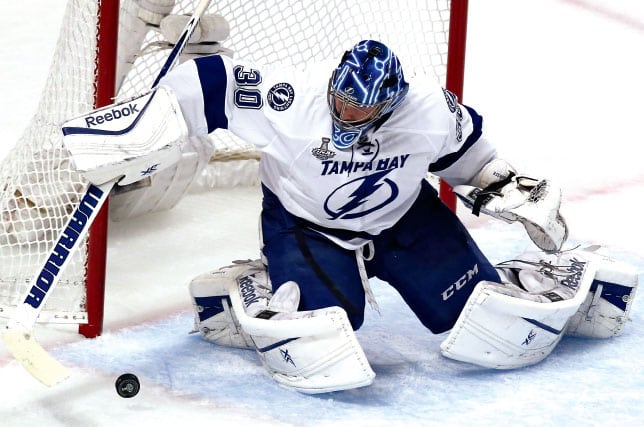
‘Battling’ Ben Bishop took long and winding road to NHL success
After toiling in the minors and being bounced around the NHL, the Tampa Bay Lightning’s Ben Bishop has arrived as an elite goaltender. No horseshoes needed.
 ‘Battling’ Ben Bishop took long and winding road to NHL success
‘Battling’ Ben Bishop took long and winding road to NHL successWhen the Montreal Canadiens chased
Ben Bishop from the net in the second round of the playoffs, Habs defenseman
P.K. Subban couldn’t resist taking a shot at the Tampa Bay Lightning goalie, saying Bishop had been “sitting on a horseshoe” to that point in the series. Subban, of course, meant to imply that said horseshoe was wedged in a certain part of Bishop’s anatomy. Subban is subtle that way. The implication was Bishop had luck rather than skill to credit for his play in that series. If that’s the case, then perhaps it was a case of karma coming around. Maybe Bishop was finally due for some good luck, because until he joined the Lightning, good fortune wasn’t something in huge supply for him. By the time Bishop was dealt to Tampa at the trade deadline in 2013, he was a 26-year-old goalie with just 36 NHL appearances and was already in his third organization. His hometown St. Louis Blues had given up on him, trading him for a second-round pick. Then with no room on their depth chart for a goalie who takes up a lot of room in the net, the Ottawa Senators dealt him to Tampa Bay for
Cory Conacher and a fourth-rounder, not the kind of bounty that has “future NHL star” written all over it.

Those deals weren’t egregious at the time. But by rescuing himself from the precipice, Bishop has made Lightning GM Steve Yzerman look shrewd. Bishop has been a godsend for the Lightning, but his health in the playoffs has been an issue. Tampa was swept in the first round last season, due in a large part to its reliance on backup netminders after Bishop went down with an injury. In the final round of the Stanley Cup playoffs, his health became a major topic again. That Bishop was able to persevere and stop 36 of 38 shots in Game 3 of the Stanley Cup final to give the Lightning a 2-1 series lead, and then continue to play in the final after missing Game 4, is a testament to his sense of determination.
It’s a quality that has served him well throughout his career. When Bishop came to the Lightning, he wasn’t on the scrap heap, but he was well on his way there. He’s grateful his GMs in St. Louis and Ottawa, Doug Armstrong and Bryan Murray, moved him to a place where he had a better chance to play. And it’s not as though Bishop had distinguished himself among the many who are chasing a limited number of spots in the best league in the world. “I thought that maybe I was ready after two years,” Bishop said. “But if you look back on it, there’s no way I was ready after two years. So three full years in the minors was probably a good thing. I learned a lot, and I know when I got to Tampa, I didn’t want to let that chance slip, being my third organization. I wouldn’t say it was a rocky road, but maybe a patient road.” Bishop’s ascension to becoming a Vezina Trophy finalist last season and playoff hero this season isn’t unprecedented. Goaltending has become the wildcard position in the NHL, which makes using a high draft pick on a goalie almost pointless. Unless, of course, you’re getting
Carey Price or
Tuukka Rask or
Jonathan Quick, three goalies who went before Bishop did in the 2005 draft. Most goaltenders have a long learning curve to the NHL, and teams often don’t have that kind of time. Frantz Jean, who worked with
Corey Crawford when both were with the Moncton Wildcats junior team, is the Lightning’s goaltending coach. He was charged with helping Bishop raise his game to the next level once Bishop got to the Lightning. Frantz said the technical adjustments weren’t extensive. “I’m a big believer that before you know what you’ve got as a goalie, it takes about 300 pro starts,” he said. “And to reach the NHL, it’s about 150 AHL starts and when you think about it, that’s about three or four years in the minors. So when guys get in at 20 or 21, it’s 24 or 25 by the time they’re ready to say, ‘OK, I’ll make my statement at the NHL level.’ It’s a big step, and I don’t think people realize how big a step it is between the AHL and NHL levels.” On the technical side, Bishop is a little, well, interesting. He has never been reticent about playing the puck and being aggressive. Sometimes it results in an eye-popping stretch pass, but at other times it creates the kind of havoc that led to the bizarre goal in Game 5 of the final when he collided with teammate
Victor Hedman.
There have been many adventures, but Bishop has settled into the role of Tampa’s No. 1 goaltender, and there’s still some upside there. “He’s got a really high hockey IQ,” Frantz said, “which is important for a goalie. He’s got an asset which nobody has, which is his size. He’s a great playmaker with the puck. And it was just a question of putting it all together and putting it into something of a game plan.” The game plan was derailed somewhat when Bishop tore his groin in Game 2 of the final and seemed to have a difficult time getting up and down. But the Blackhawks didn’t score more than two goals in any of the games they won, and Bishop, to his credit, battled to the end. “You sit here and think, ‘He played 27 games in a row before an injury took him out,’ ” said Lightning coach Jon Cooper. “At the pinnacle of the sport, going through the end of the regular season, the playoffs, for him to continue to rise in this occasion for somebody that never had been in the situation before, you can’t say enough about what he did for us.”
This is an edited version of a feature that appeared in the 2014-15 Season Commerative edition of The Hockey News magazine. Get in-depth features like this one, and much more, by subscribing now.
[embed]https://www.youtube.com/watch?v=KXCAvF8JsmY[/embed]

